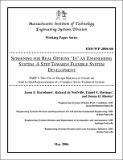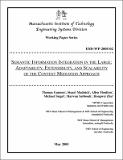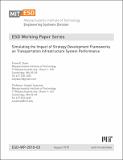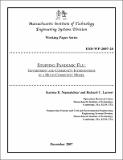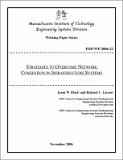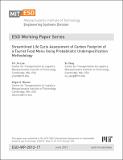Browsing Engineering Systems Division by Title
Now showing items 214-233 of 273
-
Role of Technology in Manufacturing Competitiveness
(Massachusetts Institute of Technology. Engineering Systems Division, 2003-07)A manufacturing revolution has emerged in the past 50 years that is as significant as the industrial revolution of the 19th century. From 1950 to 2000, the average productivity growth in manufacturing in the United States ... -
Screening for Real Options “In” an Engineering System: A Step Towards Flexible System Development; PART I: The Use of Design Matrices to Create an End-to-End Representation of a Complex Socio-Technical System
(Massachusetts Institute of Technology. Engineering Systems Division, 2006-05)The goal of this research is to develop an analytical framework for screening for real options “in” an engineering system. Real options is defined in the finance literature as the right, but not the obligation, to take an ... -
Semantic Information Integration in the Large: Adaptability, Extensibility, and Scalability of the Context Mediation Approach
(Massachusetts Institute of Technology. Engineering Systems Division, 2005-05)There is pressing need for effectively integrating information from an ever increasing number of available sources both on the web and in other existing systems. A key difficulty of achieving this goal comes from the ... -
Semantic Integration Approach to Efficient Business Data Supply Chain: Integration Approach to Interoperable XBRL
(Massachusetts Institute of Technology. Engineering Systems Division, 2008-01)As an open standard for electronic communication of business and financial data, XBRL has the potential of improving the efficiency of the business data supply chain. A number of jurisdictions have developed different XBRL ... -
Simulating the Impact of Strategy Development Frameworks on Transportation Infrastructure System Performance
(Massachusetts Institute of Technology. Engineering Systems Division, 2010-08)This paper develops, through a simulation model, a deeper understanding of the relationship between transportation infrastructure strategy development frameworks and system performance. A strategy development framework for ... -
SPARQL Query Mediation for Data Integration
(Massachusetts Institute of Technology. Engineering Systems Division, 2012-01)The Semantic Web provides a set of promising technologies to make sophisticated data integration much easier, because data on the semantic Web is allowed to be connected by links and complex queries can be executed against ... -
STEM Crisis or STEM Surplus? Yes and Yes
(Massachusetts Institute of Technology. Engineering Systems Division, 2014-10)Over the last decade, there has been significant concern regarding a shortage of science, technology, engineering, and mathematics (STEM) workers to meet the demands of the labor market. At the same time, many experts have ... -
Stopping Pandemic Flu: Government and Community Interventions in a Multi-Community Model
(Massachusetts Institute of Technology. Engineering Systems Division, 2007-12)Focusing on mitigation strategies for global pandemic influenza, we use elementary mathematical models to evaluate the implementation and timing of intervention strategies such as travel restrictions, vaccination, social ... -
Strategic Engineering Gaming for Improved Design and Interoperation of Infrastructure Systems
(Massachusetts Institute of Technology. Engineering Systems Division, 2012-03)Large physical networks of interrelated infrastructure components support modern societies as a collaborative system with significant technical and social complexity. Design and evolution of infrastructure systems seeks ... -
Strategies for Water Reclamation: The Role of Policy and Technology in the Las Vegas Water Supply
(Massachusetts Institute of Technology. Engineering Systems Division, 2007-01)The goals of this report are to: (i) consider Las Vegas' current water reclamation and reuse strategies using a case study framework to examine policy and reclamation technology issues in urban areas; and (ii) using this ... -
Strategies to Overcome Network Congestion in Infrastructure Systems
(Massachusetts Institute of Technology. Engineering Systems Division, 2006-11)Networked Infrastructure systems deliver services and/or products from point to point along the network. They include transportation networks (e.g., rails, highways, airports, sea ports), telecommunication networks (by ... -
Streamlined Life Cycle Assessment of Carbon Footprint of a Tourist Food Menu Using Probabilistic Underspecification Methodology
(Massachusetts Institute of Technology. Engineering Systems Division, 2012-06)We proposed a methodology based on life cycle assessment streamlining techniques to estimate the carbon footprint (CF) of a meal. The methodology was applied to estimate the meal CF of twenty-four people on a 4-days Galapagos ... -
Striving for Safety: Communicating and Deciding in Sociotechnical Systems
(Massachusetts Institute of Technology. Engineering Systems Division, 2014-09)How do communications and decisions impact the safety of sociotechnical systems? This paper frames this question in the context of a dynamic system of nested sub-systems. Communications are related to the construct of ... -
Superfund: An Assessment of Superfund Site Remedy Selectioin and Implementation
(Massachusetts Institute of Technology. Engineering Systems Division, 2007-01)Since its inception in 1980, the U.S. Environmental Protection Agency’s (EPA) Superfund Program has served as the primary mechanism for coordinating the remediation of sites contaminated with hazardous substances. Although ... -
Supply Chain Management Under The Threat Of International Terrorism
(Massachusetts Institute of Technology. Engineering Systems Division, 2002-05)On the morning of September 11th, 2001, the United States and the Western world entered into a new era – one in which large scale terrorist acts are to be expected. The impacts of the new era will challenge supply chain ... -
A Supply Chain View of Product Carbon Footprints: Results from the Banana Supply Chain
(Massachusetts Institute of Technology. Engineering Systems Division, 2012-08)Interest in the use of Life Cycle Assessment (LCA) to measure the carbon footprint of products has increased in recent years. While issues have been raised regarding the use of LCA to measure carbon footprints, the ... -
Survey Design to Unravel Freight Transportation Demand of Establishments in Cities
(Massachusetts Institute of Technology. Engineering Systems Division, 2015-05-22)Freight transportation serves the vital role of fulfilling the goods demand of residents in cities, yet little is known about the mechanisms that generate freight movements and their impact on traffic. Even though technology ... -
A Survey of Methods for Data Inclusion in System Dynamics Models
(Massachusetts Institute of Technology. Engineering Systems Division, 2014-05)In 1980, Jay Forrester enumerated three types of data needed to develop the structure and decision rules in models: numerical, written and mental data, in increasing order of importance. While this prioritization is ... -
Surviving and Thriving in the New World of Web Aggregators
(Massachusetts Institute of Technology. Engineering Systems Division, 2000-10)This paper examines the development of aggregators, entities that collect information from a wide range of sources, with or without prior arrangements, and add value through post-aggregation services. New Web-page extraction ... -
System Design and Architecture of an Online, Adaptive, and Personalized Learning Platform
(Massachusetts Institute of Technology. Engineering Systems Division, 2013-11)The authors propose that personalized learning can be brought to traditional and nontraditional learners through a new type of asynchronous learning platform called Guided Learning Pathways (GLP). The GLP platform allows ...

